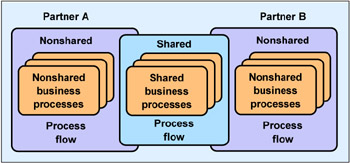4.1 General guidelines
|
| < Day Day Up > |
|
4.1 General guidelines
To help you determine if the Extended Enterprise business pattern is appropriate for the design of your inter-enterprise application integration scenario, this section details the business and IT scenario into which an Extended Enterprise solution fits.
4.1.1 Business and IT drivers
Businesses developing a solution needing the following characteristics should consider using the Extended Enterprise business pattern:
-
The business processes need to be integrated with existing business systems and information.
-
The business processes need to integrate with processes and information that exist at partner organizations.
4.1.2 Context
The general problem addressed by this pattern is illustrated in Figure 4-1 on page 72. Interactions between partners form a public process, or potentially, multiple distinct public processes. Each of these must be integrated into the private business process flows implemented by each partner. Such integration might be as simple as passing data to a particular application, or as sophisticated as initiating or resuming a multi-step workflow involving several applications and user interactions. For example, Partner A (source application) and Partner B (target application) agree upon sharing specific business processes and a process flow. Partner A invokes a public process flow that in turn may invoke a specific private internal process flow within Partner B's organization. Partner A is not concerned with the details of Partner B's private process flow. Instead, Partner A cares only about the results it expects in response to the invoked public process.

Figure 4-1: Extended Enterprise context
The "golden rule" of business-to-business integration is the less you know about the business partner's private processes and the implementation details of their applications the better off you are. This loose coupling enables organizations to evolve their applications without affecting business partner's applications.
Obviously, specific functionality supported by these applications depends on the particular details of the trading partner agreements and service level agreements between the organizations involved. Yet a survey of such applications in multiple industries reveals certain common approaches that have been successful. These commonalities of success are harvested as the various Application patterns that can be used to implement this Business pattern.
In our sample business scenario, described in Chapter 6., "Business scenarios used in this book" on page 111, ABC Electronics wants to integrate their wholesale organization with diverse external resellers. The Extended Enterprise pattern will improve organizational efficiency and reduce the latency of business events by integrating the external resellers with the inventory replenishment system and reducing the likelihood of unfilled orders. The Extended Enterprise pattern also applies a structured exchange with business partners and supports real-time access to and from applications. This will allow the resellers to receive the benefits of an updated inventory and receive real-time response of any out of stock items.
The Extended Enterprise pattern also benefits ABC Electronics by minimizing application complexity and allowing them to integrate their applications with resellers that have unique infrastructure designs. ABC Electronics will be able to leverage their current skills and legacy investments, eliminating the need for extensive retraining and infrastructure investments.
4.1.3 Solution
The Extended Enterprise pattern might consist of all or some of the following elements:
-
Business Entities, which typically:
-
Are programs, applications, or databases that exist within an organization
-
Access and connect to other business entities across the network
-
-
A network which:
-
Is based on TCP/IP and other Internet technologies
-
Can be a dedicated Wide Area Network (WAN) connection
-
-
Business rules that:
-
Manage the integration between the business entities
-
Describe Trading Partner Agreements
-
Use Workflow rules to determine the sequence of steps and the data flow that needs to be used to facilitate the integration. These rules:
-
Describe the sequence of steps that a message needs to go through before being transferred to the other business entity
-
Specify how and where the message should be delivered
-
-
Use Transformation rules to specify format and protocol transformations that need to be applied to messages that flow between the business entities
-
-
A set of interactions that includes the execution of a jointly-agreed business process
-
Patterns based on the those described in Chapter 2., "Fundamental concepts in Process Integration" on page 17.
4.1.4 Putting the pattern to use
This pattern can be observed in solutions such as:
-
An electronics retailer/wholesaler, ABC Electronics from our sample scenario, enabling external resellers to place orders to the ABC inventory management system.
-
Extended Value Chain functions within e-Marketplaces that support cross-enterprise processes such as demand planning and collaborative design.
4.1.5 What's next
If you have determined that the Extended Enterprise business pattern can provide an appropriate solution design for the application you are developing, next select an Application pattern.
If the Extended Enterprise business pattern is not appropriate for your development efforts, review the Business patterns to determine which pattern best addresses your e-business needs.
|
| < Day Day Up > |
|
EAN: N/A
Pages: 139